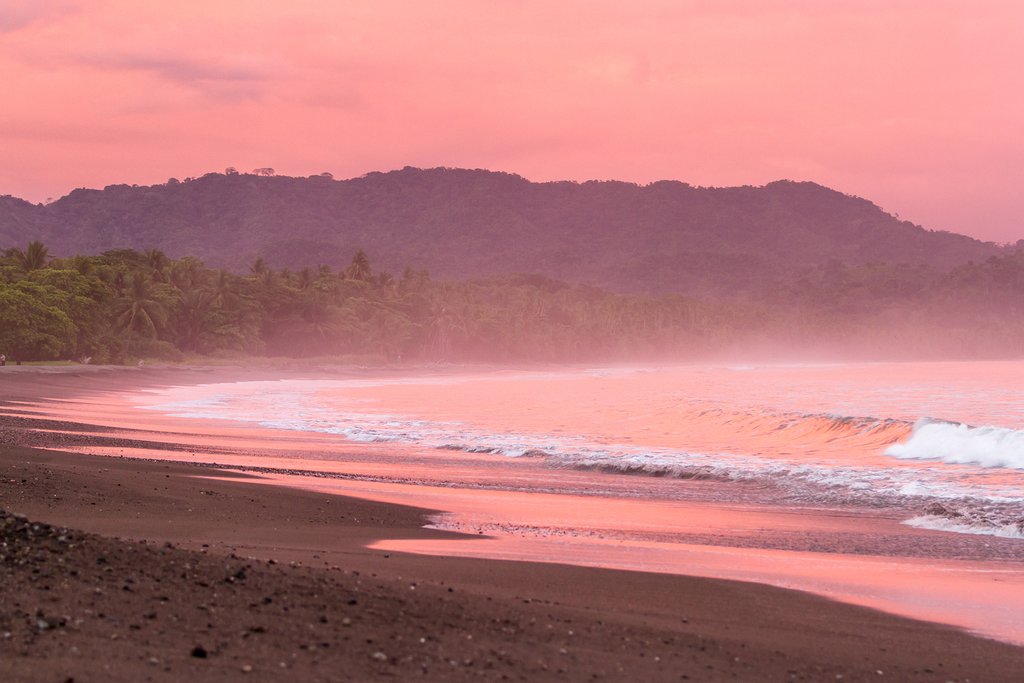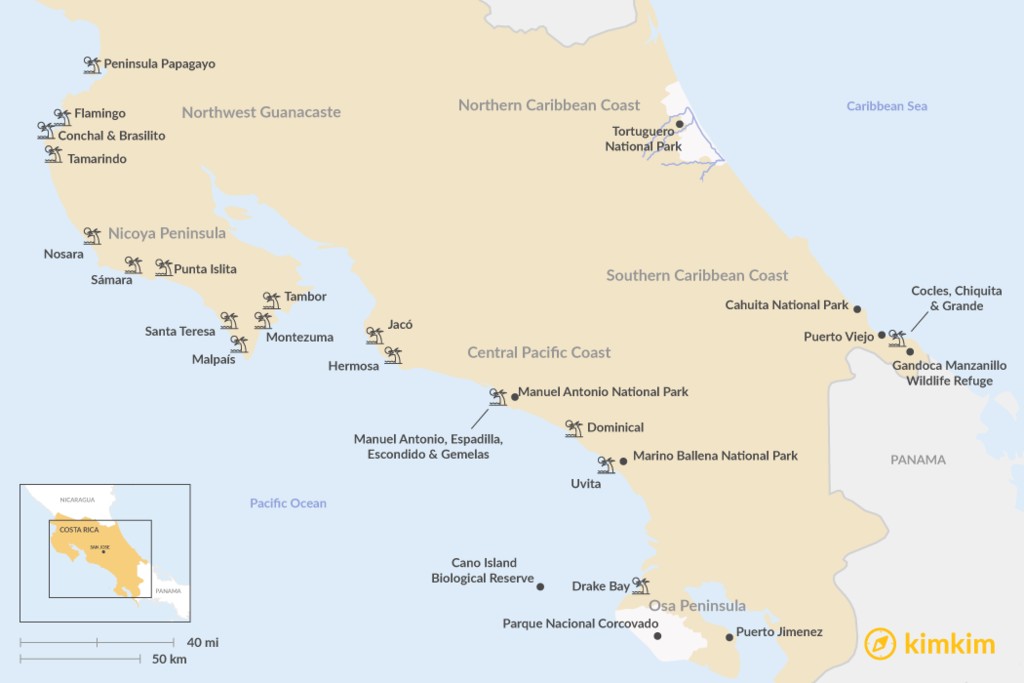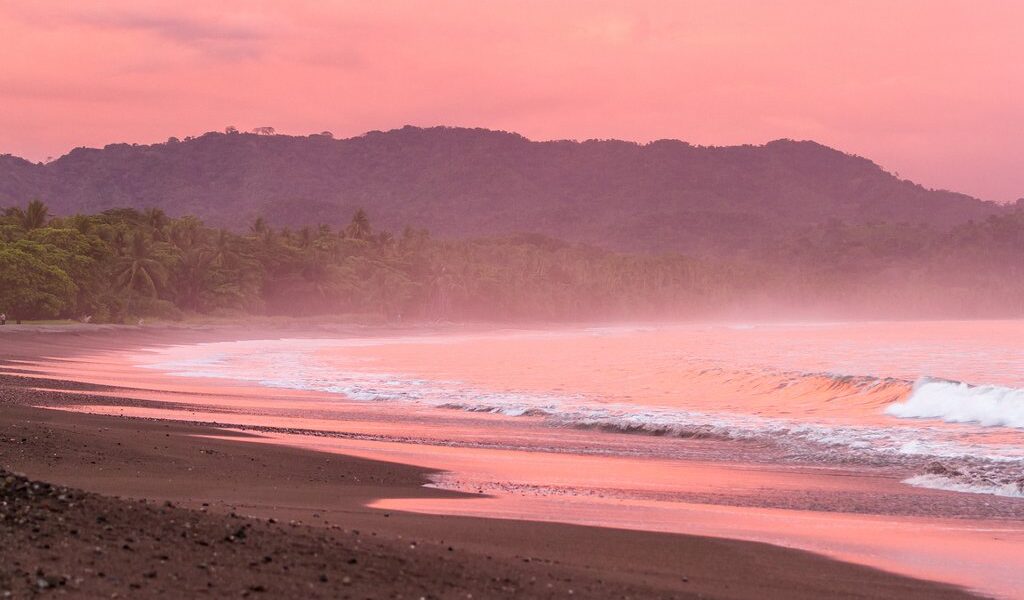
Costa Rica has nearly 300 beaches on the Pacific Ocean and Caribbean Sea. This ruggedly beautiful nation tempts travelers who want to explore white, black, and pink sands, along with water activities and spectacular natural scenery. Here is a breakdown of the best beaches in Costa Rica divided by region.
## Exploring the Diverse Beaches of Costa Rica: A Comprehensive Guide
Costa Rica, a jewel of Central America, beckons travelers with its promise of pristine beaches, lush rainforests, and vibrant culture. While the allure of the Pacific Coast, famed for its national parks and quintessential Latin American beach towns, often steals the spotlight, and the consistent waves draw surfers from across the globe, the Caribbean coast holds a unique charm that deserves exploration. Venturing east instead of west unveils a tapestry woven with African-influenced culture, remarkable wildlife encounters, and expansive vistas of the captivating turquoise sea.
The geographical layout of Costa Rica lends itself to beach hopping. Many of the country’s sandy stretches lie in close proximity, granting the opportunity to discover several distinct coastal landscapes within a single day. Beyond the well-trodden tourist paths, Costa Rica safeguards a treasure trove of remote beaches, offering immersive and intimate experiences with the surrounding natural world. To truly appreciate the diverse offerings of this tropical paradise, it’s advisable to concentrate your itinerary on one or two specific regions, allowing ample time to fully explore their unique characteristics and hidden gems.
## Discovering the Wonders of the Central Pacific Coast
The Central Pacific Coast, a region brimming with natural beauty and adventure, boasts a crown jewel that draws visitors from far and wide: Manuel Antonio National Park. This verdant sanctuary is a symphony of rolling rainforests cascading down to meet some of Costa Rica’s most inviting white-sand beaches. For first-time visitors seeking an idyllic tropical destination brimming with wildlife and a plethora of activities, Manuel Antonio is an undeniable choice. Within the park’s boundaries lie the famed Playa Manuel Antonio and Playa Espadilla, popular for their accessibility and stunning scenery. However, for those seeking a more secluded experience, the hiking trails lead to hidden paradises like Puerto Escondido and Gemelas, offering equally breathtaking beauty with a touch more tranquility.
Venturing further up the coast, you’ll encounter Playa Jaco, a town synonymous with surfing. While popular with tourists, Jaco retains an authentic atmosphere in certain pockets, making it an ideal destination for families eager to introduce their children (and perhaps themselves) to the thrill of riding the waves. Just a short drive south from Jaco lies Playa Hermosa, a renowned surfing mecca and the prestigious host of the annual Billabong Surf Championships.
For those seeking solace and uncrowded shores, the neighboring towns of Dominical and Uvita, situated further south, offer relatively undiscovered havens of white sand. These locales are particularly favored by advanced surfers seeking challenging breaks. Playa Uvita stands out for its unique geographical feature, the Whale’s Tail, a rocky formation visible during low tide. Moreover, Playa Uvita forms part of the Marino Ballena National Park, a protected area named after the majestic humpback whales that grace its waters during their annual mating season.
## Exploring the Untamed Beauty of the Nicoya Peninsula
The southwestern Nicoya Peninsula, a destination requiring a more adventurous spirit to reach, presents an ideal haven for those seeking a taste of authentic Costa Rican beach culture. Here, the unpaved roads pulsate with life as vintage SUVs, nimble ATVs, and bicycles jostle alongside young expatriates, their surfboards and yoga mats clutched tightly. Santa Teresa perfectly encapsulates this bohemian charm, its expansive coastline offering exceptional swells, mesmerizing sunsets, and a vibrant beach scene that is among the best in the country.
If the desire for a more tranquil escape beckons, Mal Pais, the serene neighbor of Santa Teresa, provides a welcome respite from the social scene. Alternatively, the quaint fishing hamlet of Tambor offers a charming retreat. Nestled within an open volcanic valley, Playa Tambor, its beach, is an excellent spot for swimming and relaxation. Further along the coast, the bohemian enclave of Montezuma awaits, tucked away at the foot of a steep hill. Here, secluded beaches offer encounters with local wildlife, where monkeys, butterflies, and exotic birds roam freely.
As you journey north towards Guanacaste, the roads improve, attracting a greater influx of tourists. Even so, the notable beach towns of Punta Islita and Samara are worth a visit. Nosara, renowned for its surf and yoga culture, draws sophisticated and health-conscious travelers. Its long, powdery stretch of sand boasts minimal development along the beach, making it a rare coastal gem.
## Discovering the Sunshine and Convenience of Northwest Guanacaste
Located within an hour’s drive from Liberia International Airport, Northwest Guanacaste is renowned for its reliable sunshine and dry climate. This inviting region attracts families seeking modernity and convenience. Often referred to as the “Gold Coast,” this area boasts well-paved main roads, a stark contrast to some other parts of the peninsula.
Tamarindo is one of the most vibrant and bustling beach towns in Costa Rica, offering a wide array of mainstream shops, diverse restaurants, and a lively nightlife scene. Its location along a string of beaches makes it ideal for swimming, boogie boarding, and learning to surf. Numerous instructors and surf camps cater to beginners and experienced surfers alike.
For a truly unique beach experience, Playa Conchal, one of the most exotic beaches on the Gold Coast, stands out. Instead of traditional sand, this beach is comprised of crushed seashells, stretching for two-and-a-half miles. The waters here are exceptionally clear, making it ideal for snorkeling amidst colorful tropical fish and graceful stingrays. A short walk leads to the neighboring beaches of Playa Brasilito, while a 15-minute drive will take you to Playa Flamingo, a rare gem boasting pink sand.
While most beaches in Costa Rica are open to the public, Peninsula Papagayo hosts a luxury gated community, home to the Four Seasons and Andaz Resorts. This exclusive enclave features private residences, a beach club, a championship golf course, and a full-service marina. The bright green waters of the Pacific Ocean gently lap against a landscape of small inlets and hidden coves, creating particularly stunning beach views.
## Exploring the Biodiversity of the Northern Caribbean Coast
Venture to the northern side of the Caribbean coast and discover Costa Rica’s own version of the Amazon: Tortuguero National Park. This remarkable region, accessible only by air or water, stands as one of the wettest areas in the country, receiving an impressive 200 inches of rainfall each year. This abundance of moisture fuels an extraordinary level of biodiversity.
Reaching Tortuguero requires patience and a sense of adventure, but the reward is well worth the effort. Upon arrival, you will be greeted by a long, pristine beach and a captivating network of canals, lagoons, and wetlands. Tortuguero serves as a vital nesting ground for four different species of sea turtles, who faithfully return each year to lay their eggs from March through October. Among these magnificent creatures, the endangered green sea turtles are particularly noteworthy, reaching weights of up to 400 pounds and laying as many as 700 eggs per season.
## Immersing Yourself in the Culture of the Southern Caribbean Coast
The Southern Caribbean Coast presents a unique and captivating experience, where you’ll encounter Costa Rica’s increasingly popular (yet still largely undiscovered) Caribbean beach culture. A natural gateway to this region is the charming fishing village of Puerto Viejo de Talamanca, surrounded by peaceful beaches with pleasant temperatures year-round. Just north of Puerto Viejo, you’ll find the vibrant turquoise and emerald green waters of Cahuita National Park, home to a thriving 600-acre coral reef. Bring your snorkel gear and explore the underwater wonders, or wander along the hiking trails that lead to different beaches, offering frequent sightings of monkeys, sloths, iguanas, and parrots.
Heading south of Puerto Viejo, you’ll discover notable beaches such as Punta Cocles (perfect for surfing), Playa Chiquita, and Playa Grande. Further south still lies Manzanillo, a hidden gem nestled near the Panamanian border. This tranquil haven boasts soft white sand, stunning blue water, and lush surrounding vegetation. Protected by the Gandoca Manzanillo Wildlife Refuge, its vibrant coral reef attracts snorkelers and scuba divers from around the world.
## Discovering the Untamed Beauty of the Osa Peninsula
The wild and untamed beaches of the Osa Peninsula offer a sense of seclusion and untouched natural beauty. Corcovado National Park, the region’s largest protected area, boasts 23 miles of dramatic coastline characterized by black sand beaches fringed by dense tropical rainforest. Here, you are unlikely to encounter many other travelers. However, it’s important to exercise caution while swimming, as schools of hammerhead and bull sharks are known to frequent these waters.
On the northern side of the peninsula, you’ll find the rustic village of Drake Bay, home to several tiny, unnamed beaches. Across the peninsula lies Puerto Jimenez, a picturesque bay offering some of the calmest waters in the country. From here, embark on a dive or snorkel tour to the Cano Island Biological Reserve, where you can witness an abundance of marine life, including pufferfish, turtles, manta rays, moray eels, and barracuda.

B-560

